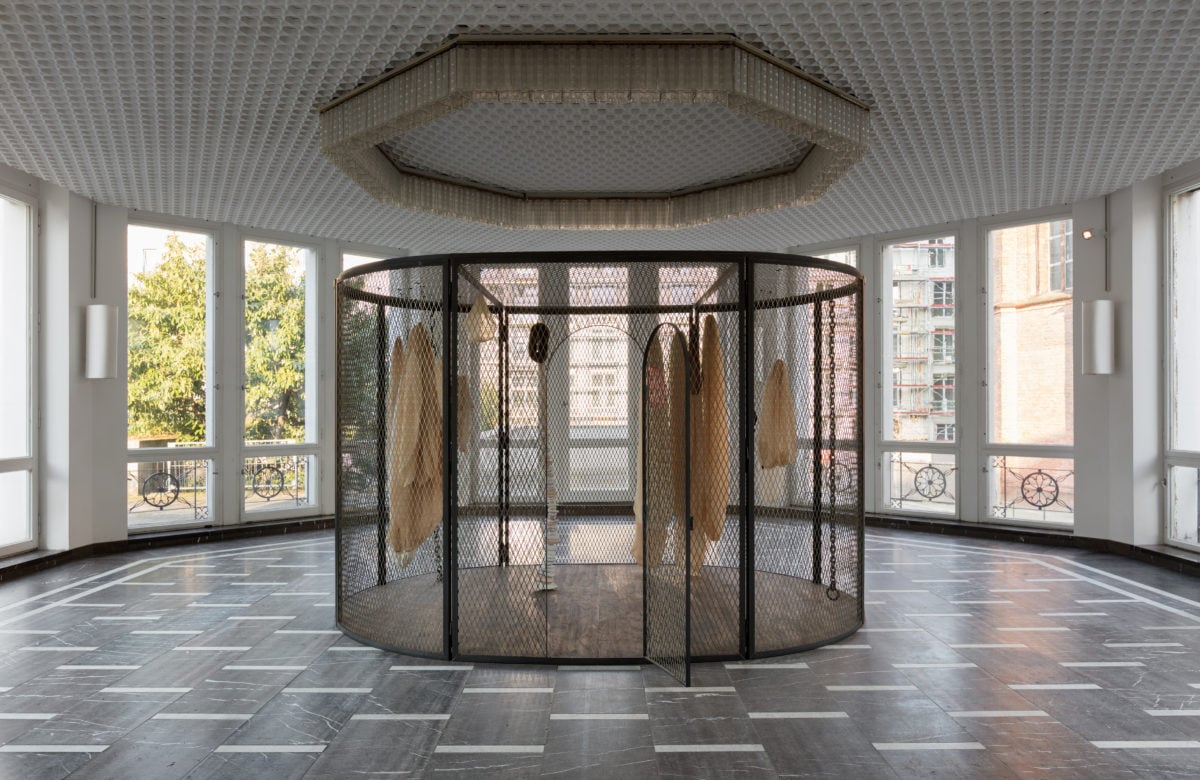
Berlin has seen a flurry of powerful solo exhibitions by seasoned female artists of late. Louise Bourgeois’s current exhibition at Schinkel Pavillon, “The Empty House,” is no exception. On view until July 29, the extensive presentation is one of Schinkel’s most ambitious yet and marks the French artist’s first solo effort in the city in more than a decade.
Nestled in the shadow of the forthcoming Humboldt Forum, Schinkel is known for a rigorous program that alternates between contemporary art, emerging artists, and more established, historical artists. The two-story, octagonal building is an unusual setting for Bourgeois; one level boasts floor-to-ceiling windows while the other is outfitted in kitchen tiles. The challenge posed by that layout involved bringing Jerry Gorovoy—the artist’s assistant of 30 years and head of the Bourgeois Trust—to Berlin to see the space and give it a stamp of approval.
The works on view have been brought in from private collections in New York, London, and Switzerland. Nina Pohl, Schinkel’s founder and director, said that it took two years to bring the exhibition together. “I couldn’t have imagined the challenge this would pose to our institution,” she told artnet News.
Mounting the show involved no small amount of preparation. In order to host works that require such intensive archival care, the museum had to introduce a new climate control system and then monitor the temperature and humidity levels for six months. “After filling in intricate tables full of small numbers that really looked more like a Hanne Darboven work than anything else, Tate agreed to loan us the work—thankfully without requiring armed forces in front of the doors, bulletproof glass, and double security doors,” Pohl joked. “And that’s when the actual adventure started.”
The museum’s efforts appear to have paid off. “The Empty House” is the first dedicated exhibition to showcase Bourgeois’s “sack forms,” a loose series that came to define her practice in the final years before her death. Presented in vitrines and a large cage, these works’ soft and domestic sensibility belies a brutal and empirical framework. Alongside fleshy watercolors—also from her late works in the mid-2000s—there are signature stitched sculptures and a must-have spider. It’s an intensely focused show that captures the deeply personal and poignant voice that Bourgeois brought to female sexuality, in all of its complexity.
See works from “The Empty House” below.
Peaux de Lapins, Chiffons Ferrailles à Vendre Detail (2006).
Collection The Easton Foundation. ©The Easton Foundation/VG Bild-Kunst. Photo: Andrea Rossetti.
Exhibition view of “The Empty House” at Schinkel Pavillon, (2018). © The Easton Foundation/VG Bild-Kunst. Photo: Andrea Rossetti.
Exhibition view of “The Empty House” at Schinkel Pavillon, (2018). © The Easton Foundation/VG Bild-Kunst. Photo: Andrea Rossetti.
Untitled (2007). Courtesy private collection, Switzerland. © The Easton Foundation/VG Bild-Kunst, Photo: Andrea Rossetti.
Umbilical Cord, (2003). Private Collection © The Easton Foundation/VG Bild-Kunst, Photo: Andrea Rossetti.
Umbilical Cord, Detail (2003). Private Collection © The Easton Foundation/VG Bild-Kunst, Photo: Andrea Rossetti.
Couple, Detail (2003). Collection Louise Bourgeois Trust. © The Easton Foundation/VG Bild-Kunst, Photo: Andrea Rossetti.
Couple (2003). Collection Louise Bourgeois Trust. © The Easton Foundation/VG Bild-Kunst, Photo: Andrea Rossetti.
The Feeding (2007). Collection Louise Bourgeois Trust. © The Easton Foundation/VG Bild-Kunst, Photo: Andrea Rossetti.
Spider, (2003). Collection Louise Bourgeois Trust. © The Easton Foundation/VG Bild-Kunst, Photo: Andrea Rossetti.
Exhibition view of “The Empty House” at Schinkel Pavillon, (2018). © The Easton Foundation/VG Bild-Kunst. Photo: Andrea Rossetti.
Louise Bourgeois “The Empty House” at Schinkel Pavillon in Berlin, Germany, is on view from April 21 to July 29, 2018.